On July 26, an alert was sounded as heavy rain in the mountains near the Amarnath shrine triggered flash floods. Over 4,000 pilgrims camping in tents were evacuated from the area and safely brought back to Panchtarni, the last camp en route to the holy cave located in the upper reaches of the Himalayas at 3,880 metres above sea level in south Kashmir. The scenes were reminiscent of the July 8 flash flood that was set off by heavy downpour near the shrine, resulting in the death of 15 pilgrims. Fifty-five persons were also injured in the incident, with water gushing down mountain passes and washing away a few tents and langar stalls. Rescue operations went on for six days.

Yet, the next morning, the 26th batch of devotees left Jammu for the twin base camps of the pilgrimage. A senior Jammu and Kashmir government official says pilgrims are not deterred by the threat of flash floods. “There has been no dip in footfall after the July 8 incident. Though the yatra was suspended for a couple of days to carry out rescue work, we were inundated with calls to immediately resume the pilgrimage.”
This year, the Union government and the J&K administration have pulled out all the stops to ensure the smooth conduct of the 43-day annual pilgrimage that was stalled for the last two years owing to the COVID-19 pandemic. The government has made arrangements on a grand scale to highlight the overall improvement on the security front in the Union Territory following the removal of Article 370 of the Constitution, which accorded special status to J&K.
Over the past two months, Union Home Minister Amit Shah has chaired a series of meetings with National Security Adviser Ajit Doval to review the preparedness for the pilgrimage. The J&K administration and the police were asked to brace for eight lakh pilgrims.
Every year, thousands of pilgrims trek on foot or by pony or palanquin the challenging mountainous terrain to the about 15-foot-high cave to worship the Shivling, which is a nearly seven-foot-tall naturally formed ice stalagmite, representing Lord Shiva, the Hindu god of destruction and regeneration. Next to the Shivling are two smaller ice stalagmites, representing Goddess Parvati and Lord Ganesha. The cave is covered with snow most of the year barring a short period of time in summer when it is opened for pilgrims.
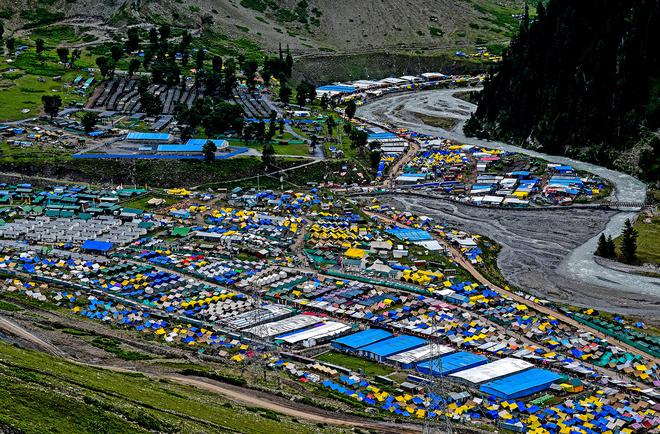
Over 2.7 lakh pilgrims have so far offered prayers at the cave shrine since June 29, the day the first batch of 4,890 pilgrims was flagged off by J&K Lieutenant-Governor Manoj Sinha. Of the 1,147 devotees in the latest batch, 476 headed for Baltal, the 14-km shorter route in central Kashmir’s Ganderbal district, in 18 vehicles, while a second convoy of 29 vehicles carried 671 pilgrims towards the 48-km Nunwan-Pahalgam mountain trail in south Kashmir’s Anantnag district amid security provided by the Central Reserve Police Force (CRPF).
The yatra is scheduled to end on Shravan Purnima, which falls on August 11 and coincides with Raksha Bandhan.

‘Irresistible force’
Kuldeep Chaturvedi, a 63-year-old retired government employee from Kanpur who is all set to embark on his 24th visit to the shrine, says, “People visit Amarnath — the place chosen by Lord Shiva to reveal the secret of immortality (Amar Katha) to Goddess Parvati — in search of salvation. According to lore, before starting his journey to the cave, Lord Shiva gave up all his possessions. There is a ‘current’ in the cave that draws you and you can’t hold back.”
Mr. Chaturvedi is a regular on the pilgrimage circuit: he has visited Kedarnath 10 times, Kailash Mansarovar thrice, Panchkedar twice and embarked on the Aadi Kailash yatra for the first time last month. “In the West, people go on adventure treks seeking rejuvenation. In India, we go to Amarnath. An adventure keeps you alive, active and happy. It helps you find out how much power you possess and how much more you have to gain,” he says. He, however, rues the rampant commercialisation of the holy site. “Earlier, devotees came in search of salvation. Now, it is more of a photo opportunity for people.”
Mr. Chaturvedi says he once witnessed a terror attack and had to spend the night at a Hanuman temple in Srinagar after a high alert was sounded. Yet, driven by devotion, he returns every year to pay obeisance to the Shivling.
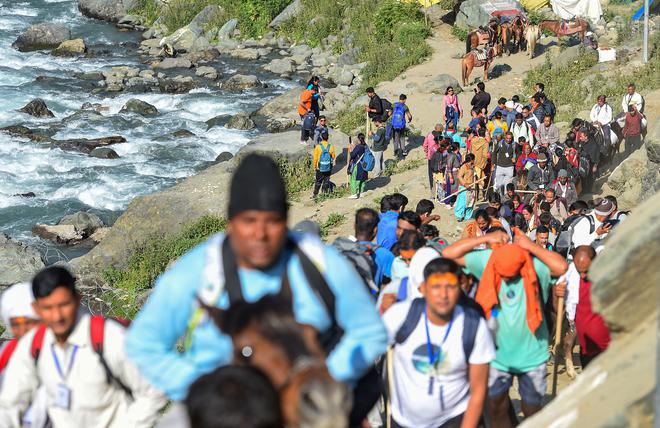
Karamjeet Singh ‘Bhola’, who has been visiting the Amarnath shrine for the past 48 years, says he will turn 71 this year but his advanced age has not dampened his desire to undertake the yatra. Mr. Singh, who owns a travel agency, says he visited the shrine for the first time during the monsoon of 1971. He was accompanying a group of students who were travelling from Muktsar Sahib district in Punjab to Srinagar, and they decided to trek to the shrine.
“The yatra wasn’t so popular then. Very few people use to embark on the pilgrimage owing to the dangerous terrain and security threat. I can’t recall what moved me, but I just decided to join the group heading for the yatra. Since then, I have been coming to the shrine every year,” he says.
Mr. Singh says till he turned 60, he used to travel on foot to the shrine from the Chandanwari and Baltal base camps. However, with age catching up, he started trekking halfway and riding a pony to cover the remaining stretch. “The pandemic has made all of us lethargic. I had to undertake the entire yatra by pony this year. I completed the pilgrimage on July 8, the day a flash flood near the cave claimed several lives. But I will continue to visit Amarnath till my last breath,” says Mr. Singh, who witnessed the heavy rain near the cave in 1996 that led to the death of 240 yatris.
He says he still gets goosebumps recalling the sight of bodies strewn on the roads following the 1996 deluge. “Army personnel came and carried the bodies on their backs and on stretchers. We had to wait at Pahalgam and watch the trail of death as 12 members of our group had gone missing. We managed to find them in the end, but that was the worst year of the yatra,” he says.

Fulfilling a promise
Sajan Bajaj, a 31-year-old graphic designer from Mohali who arrived for the ‘darshan’ for the 10th time, says he decided to go ahead with the yatra despite the risk of death looming large after the flash floods. “I was just 18 when I visited Amarnath for the first time. Since then, I can sense a connection with this place. I forget all the mundane and worldly things when I am at the shrine.”
Mr. Bajaj, who became a father two months ago, says there was a “big reason” why he embarked on the pilgrimage this year. “When my son was born in May, the doctors told us that he is in a critical condition. I prayed to Lord Shiva and pledged to walk up to him again if he would save my child’s life. He did and I had to come to express my gratitude.”
Mr. Bajaj, however, criticised the Shri Amarnathji Shrine Board (SASB), which manages the annual pilgrimage, for not making use of the two-year hiatus owing to COVID-19 to improve facilities along the twin routes to the shrine. “Everything was shut for the past couple of years. They could have constructed roads or built permanent tents. All they do is to loot people in the name of the yatra.”
Mr. Bajaj says he secured the travel pass for the pilgrimage after shelling out ₹1,500 against the actual price of ₹220. He says from ponies to tents and even palanquin rides, pilgrims have to pay a hefty price. “I remember when I went to Amarnath in 2009, the yatra cost me ₹5,000. I have spent ₹30,000 this year.”
Vinita Mishra, a 56-year-old writer from Lucknow, undertook the Amarnath yatra for the first time this year, that too all by herself. Ms. Mishra, who calls herself a “wanderer”, says she started travelling alone as her husband, a paediatrician, refused to accompany her even after his retirement. She says the yatra is a “mystical experience”.

‘A signal from God’
“I secured the pass to begin the yatra on July 12, but my trip was postponed due to the flash flood. I felt sad thinking about the money I would lose by rescheduling my flight tickets. However, I later realised that Lord Shiva wanted me to receive his ‘darshan’ in the auspicious month of Shravan, which began on July 14. I was a bit anxious to travel alone, but I met a group in Srinagar to travel with. The other surprise was a signal from God. We were told that the yatra would be cancelled due to inclement weather the day we were scheduled to trek, but later the route was opened for barely an hour. That was the sign for me that my time had come to witness the magical cave for the first time,” she says.
Ms. Mishra, who vows to return to the shrine next year, says the yatra gave her a different perspective to life. “Here everyone was unknown to each other, still all were helping one another. This is what pilgrimages teach you. The entire world belongs to us, yet nothing is predictable on earth, just like the weather conditions at Amarnath. It is sunny for a moment and then the heavens open the next minute. This is how devotees yearning for salvation climb the mountains to meet their Lord,” she says.
Gaurav Kusum Bhardwaj, 38, from Agra, and Naveen Kumar, 32, from Delhi, say the yatra is a “highly spiritual experience”. The duo, who live 250 km apart, was undertaking the yatra for the first time. “According to the old adage, faith can move mountains. At Amarnath, mountains fail to deter devotees,” says Mr. Bhardwaj.
‘Saved by the Almighty’s grace’
It was an “unforgettable experience” for Jayesh Sharma, 31, from Udaipur who had embarked on the yatra along with his wife’s family. He was among the hundreds of pilgrims who were approaching the shrine on July 8 when the flash flood claimed several lives. “I saw bodies floating in the water. My wife, who had stayed back at home with our child, was worried as her family — mother, father, brother and sister — was with me in Amarnath and she could not contact us as we had lost mobile network connectivity. But by the grace of the Almighty, we escaped unhurt. The horror left me and I attained peace when I entered the holy cave. I will visit Amarnath again just for this experience,” he says.
Radha Krishna, an elderly man from Ludhiana who was rescued by Indo-Tibetan Border Police (ITBP) personnel from the shrine during the flash flood, says he cannot thank God enough for protecting his life. “Mai bach ke aa gaya, yahi bahut hai (I returned alive, this is more than enough for me),” he says.

Automatic feedback system
Shankar Naik, a 54-year-old tourism department official from Goa, says he was visiting the shrine along with five friends when they got trapped at the shrine during the flash flood. “The Amarnath yatra supports the economy of J&K to a great extent. Yet, the services are bad. A diabetic person like me can’t get a cup of sugar-free tea here to find comfort after enduring the trauma of a flash flood. There were no arrangements for hot water even when the temperature dipped,” he says.
According to the J&K administration, it seeks feedback from about 100 pilgrims every day based on 20 parameters, including sanitation, food, lodging and transportation facilities.
“The sample size is 100 for now and the approval rating currently stands at about 90%. There is an automatic feedback system, developed by the National Informatics Centre, which sends SMSes seeking feedback to 23,000 registered pilgrims in one go,” says an official.
He adds that 1,500 civic personnel have been deployed along the yatra routes to ensure proper sanitation facilities and maintenance of hygiene. “We have urged pilgrims to refrain from littering and informed them about the designated spots for disposal of garbage.”
This year, for the first time, every Amarnath yatra pilgrim has been insured for ₹5 lakh. The Lieutenant-Governor, who is also the chairman of the SASB, has directed authorities to ensure the availability of an adequate number of oxygen cylinders at altitudes above 6,000 feet and the deployment of ambulances and helicopters to deal with emergencies. “ITBP personnel have been deployed in the upper reaches to provide oxygen. Over 2,500 pilgrims have been provided with oxygen facilities so far,” says an ITBP official.
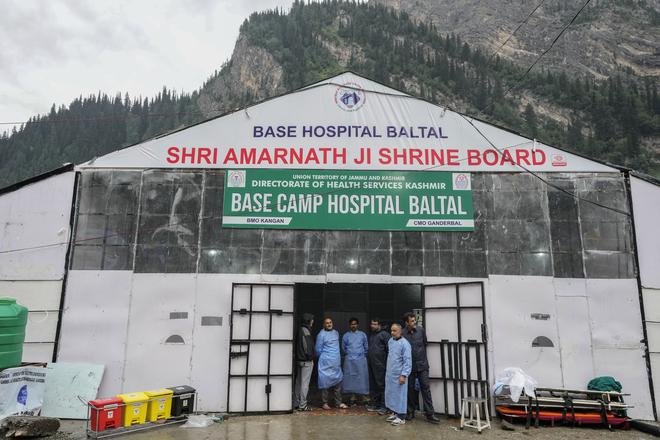
The number of tents en route to the shrine have also been increased from 29,000 in 2018 to 70,000 this year. Six base hospitals have also been established for the first time and COVID care hospitals with ICUs have been set up at Pahalgam, Baltal and Sonamarg.
‘Darshan’ in a day, RFID tags
In another first, the SASB has started helicopter services for pilgrims who want to complete the ‘darshan’ in a day. Earlier, the services were operational only in two sectors near the base camps in south and central Kashmir. They are now available in four sectors: Srinagar airport to Neelgrath, Srinagar airport to Pahalgam, Neelgrath to Panchtarni, and Pahalgam to Panchtarni. Eleven helicopters are running the service.
Stringent security measures were put in place, including attaching vehicles with RFID (radio frequency identification) tags, after eight persons were killed when a bus carrying Amarnath pilgrims from Gujarat was attacked by Lashkar-e-Taiba terrorists near Batingoo in Anantnag district in 2017.
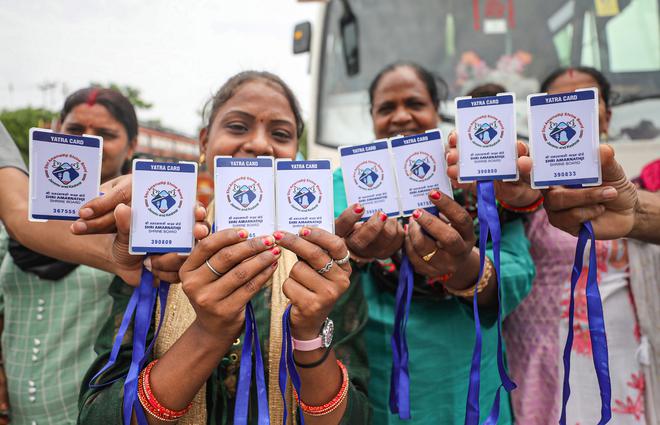
This year, the SASB has provided RFID tags to all pilgrims to track their movement. Due to heightened security threats, paramilitary forces drawn from the CRPF, ITBP and Border Security Force (BSF) have been deployed in large numbers in addition to the local police.
According to a senior Home Ministry official, the ITBP, CRPF and BSF personnel were the first to respond to the flash flood on July 8. “They immediately sent photos and videos of the site and helped us quickly disseminate information. Immediately a helpline was set up for the relatives of the pilgrims,” he says.
On July 27, Union Minister of State for Home Nityanand Rai informed the Rajya Sabha that no person was reported missing after the deluge. “The pilgrims were immediately evacuated to safer places and camps, and provided accommodation and food while the injured pilgrims were moved to the nearest medical facilities,” he said.
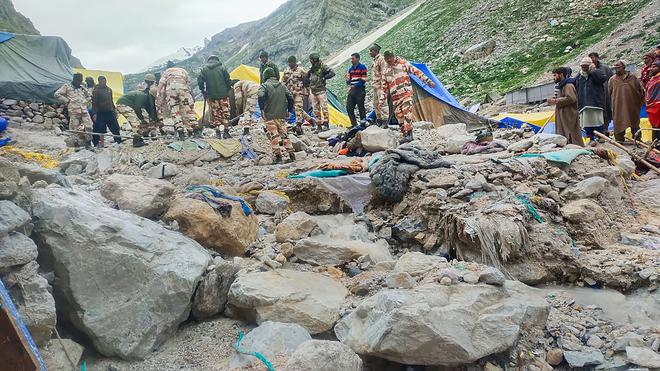
Demarcate fragile zones: scientist
According to Vikram Gupta, senior scientist at the Wadia Institute of Himalayan Geology, Dehradun, proper demarcation of fragile zones can save lives during calamities at pilgrim sites. “Tents were put up in an area prone to flooding. Lives could have been saved if this zone was clearly demarcated.”
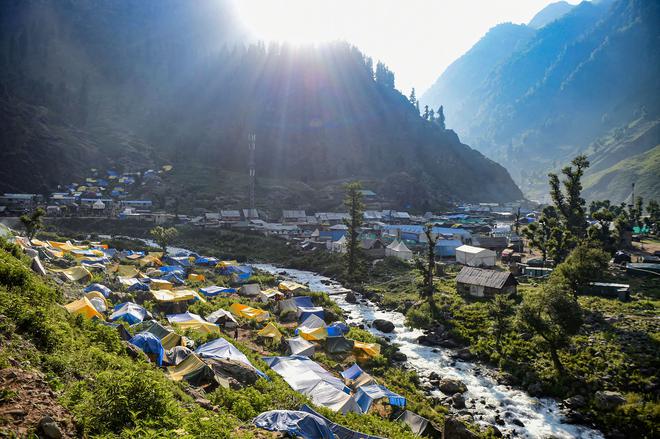
Dr. Irfan Rashid, assistant professor at the Department of Geoinformatics, University of Kashmir, says scientifically determining the carrying capacity of a place prone to floods is the only way to safeguard human lives as it is difficult to accurately forecast sudden changes in weather. “If this land, frozen for years, lying on a steep slope experiences more heat, it might destabilise and result in rock fall, avalanches and debris flow, similar to what the pilgrims experienced on July 8. When you place 10,000 people in a glaciated environment, it is obvious that the amount of heat in the system will go up. To determine the carrying capacity of the place, one must take into account the pilgrims visiting the cave and the support system that is present to facilitate the yatra,” he says.







